Compact inverters are essential for connecting your grid-tied vertical axis wind turbine (VAWT) to the power grid. These devices convert the DC power from your turbine into AC power compatible with your home and the grid. When choosing an inverter, consider its size, efficiency, and grid synchronization capabilities. Look for models with high power density, advanced cooling systems, and smart grid features. Make sure the inverter's capacity matches your turbine's output and meets local grid requirements. Proper installation and maintenance are key to peak performance. By understanding the latest advancements in inverter technology, you'll be better equipped to maximize your VAWT's energy production and grid integration.
Understanding Grid-Tied VAWT Systems
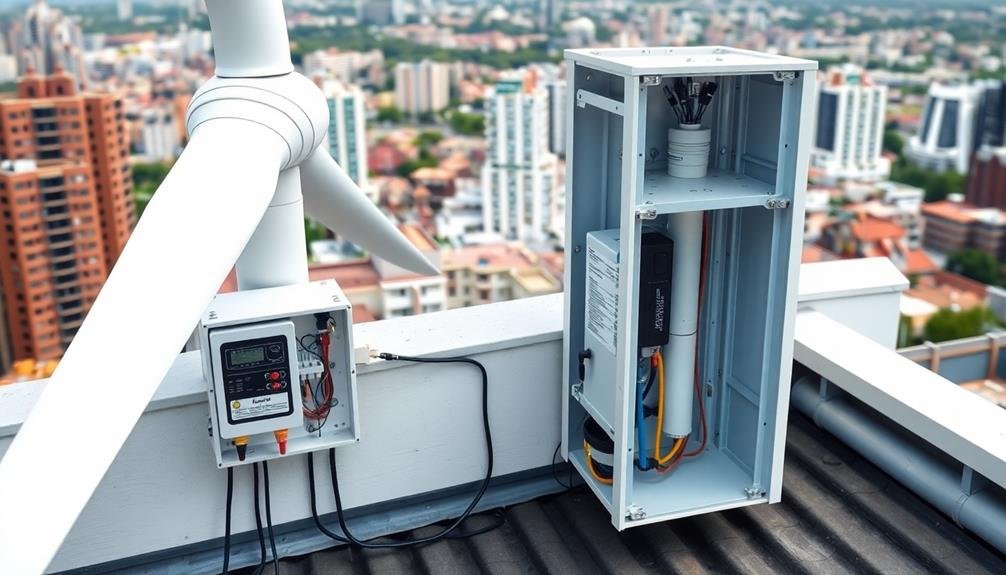
Grid-tied Vertical Axis Wind Turbine (VAWT) systems are the unsung heroes of small-scale renewable energy. These innovative setups connect directly to your local power grid, allowing you to harness wind energy and potentially reduce your electricity bills.
Unlike their horizontal-axis counterparts, VAWTs can capture wind from any direction, making them ideal for urban and suburban environments.
When you install a grid-tied VAWT system, you're fundamentally creating a mini power plant on your property. The turbine generates AC electricity, which is then converted to grid-compatible power by an inverter. This power feeds into your home's electrical system, offsetting your energy consumption from the grid.
Any excess electricity you produce is fed back into the grid, often earning you credits on your utility bill.
It's important to understand that grid-tied systems don't provide power during outages, as they're designed to shut off for safety reasons. You'll need to work with a certified installer to guarantee your system meets local codes and utility requirements.
Inverter Basics for Wind Turbines
You'll find that inverters play an essential role in wind turbine systems by converting DC power to AC power suitable for grid connection.
These devices employ sophisticated grid synchronization techniques to guarantee the output matches the frequency and phase of the utility grid.
Additionally, inverters incorporate power quality control features to maintain voltage stability and reduce harmonic distortion, enhancing overall system efficiency and reliability.
DC to AC Conversion
Inverters play an essential role in converting the DC power generated by vertical axis wind turbines into usable AC electricity for your home or the grid. The DC to AC conversion process involves several key steps and components.
First, the inverter takes the variable DC input from your turbine and smooths it using capacitors. Then, it employs high-speed switches, typically MOSFETs or IGBTs, to create a high-frequency AC waveform. This waveform is then shaped into a clean sine wave using filters and transformers.
Modern inverters use sophisticated control algorithms to optimize efficiency and power quality. They'll also synchronize the output with the grid frequency and voltage, ensuring seamless integration.
Here's a breakdown of the key stages in DC to AC conversion:
| Stage | Function | Key Components |
|---|---|---|
| Input | Smooth DC | Capacitors |
| Switching | Create AC | MOSFETs/IGBTs |
| Waveform Shaping | Clean Sine Wave | Filters, Transformers |
| Control | Optimize Output | Microprocessors |
| Synchronization | Match Grid | Phase-locked Loops |
You'll find that compact inverters for vertical axis turbines are designed to be efficient, reliable, and easy to install. They often include features like maximum power point tracking (MPPT) to extract the most energy from your turbine under varying wind conditions.
Grid Synchronization Techniques
Synchronizing your vertical axis wind turbine's output with the grid is a vital function of compact inverters. These devices guarantee that the electricity generated by your turbine matches the grid's voltage, frequency, and phase angle. This synchronization is essential for seamless integration and efficient power delivery.
You'll find that modern inverters use sophisticated techniques to achieve grid synchronization. Phase-locked loop (PLL) systems are commonly employed to track the grid's frequency and phase. These systems continuously adjust the inverter's output to maintain alignment with the grid's parameters.
Another technique you might encounter is voltage source converter (VSC) technology. VSCs use pulse width modulation to create a sinusoidal output that closely matches the grid's waveform. This approach allows for precise control of active and reactive power flow.
Some advanced inverters incorporate adaptive synchronization algorithms. These methods can quickly respond to grid fluctuations and maintain stability during disturbances.
You'll also find that many inverters now use digital signal processors (DSPs) for real-time monitoring and control, enhancing their ability to maintain synchronization under varying conditions.
Power Quality Control
Power quality control lies at the heart of effective inverter operation for vertical axis wind turbines. You'll need to guarantee that the power fed into the grid meets strict standards for voltage, frequency, and harmonic content. To achieve this, your inverter must employ advanced control algorithms and filtering techniques.
You'll want to focus on maintaining a stable output voltage, typically within ±5% of the nominal grid voltage. This involves implementing voltage regulation systems that can quickly respond to fluctuations in wind speed and load conditions.
For frequency control, you'll need to synchronize the inverter's output with the grid frequency, usually 50 or 60 Hz, depending on your location.
Harmonic distortion is another vital aspect you must address. Your inverter should incorporate active or passive filtering to reduce total harmonic distortion (THD) to less than 5%, as per most grid codes.
You'll also need to implement power factor correction to guarantee the inverter operates at near-unity power factor, maximizing energy transfer efficiency.
Lastly, don't forget about fault ride-through capabilities. Your inverter should be able to withstand short-term grid disturbances without disconnecting, guaranteeing grid stability and compliance with modern grid codes.
Compact Inverter Technology Advancements
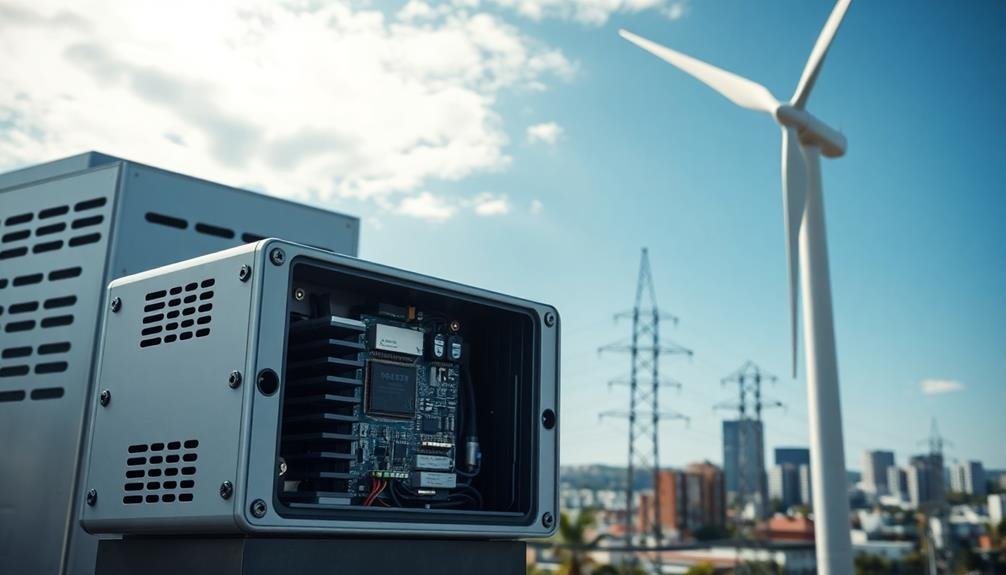
Recent years have seen compact inverter technology leap forward, driven by the growing demand for efficient power conversion in renewable energy systems. You'll find that these advancements have markedly improved the performance and reliability of vertical axis turbines.
The latest compact inverters boast higher power density, allowing for smaller footprints without sacrificing efficiency. They've also incorporated advanced cooling systems, enabling them to operate in harsh environments without overheating. You'll notice that modern inverters feature improved power electronics, resulting in faster switching speeds and reduced energy losses.
To better visualize these advancements, consider the following improvements:
- Miniaturized components that fit in the palm of your hand
- Sleek, streamlined designs that blend seamlessly with turbine structures
- Digital displays providing real-time performance data
- Plug-and-play connectivity for easy installation and maintenance
These technological leaps have made compact inverters more accessible and cost-effective for vertical axis turbine applications.
You'll find that they now offer enhanced grid integration capabilities, smoother power output, and improved fault ride-through performance. As a result, you can expect better overall system efficiency and reduced maintenance requirements, making vertical axis turbines an increasingly attractive option for renewable energy generation.
Sizing Inverters for VAWTs
With compact inverter technology advancing rapidly, it's important to focus on proper sizing for vertical axis wind turbines (VAWTs). When selecting an inverter for your VAWT, you'll need to take into account several factors to guarantee peak performance and efficiency.
First, determine your turbine's maximum power output. You'll want an inverter that can handle this peak capacity while allowing for some headroom. Typically, you should choose an inverter with a rated capacity 10-20% higher than your turbine's maximum output.
Next, evaluate your site's wind conditions. If you're in an area with highly variable winds, you might opt for an inverter with a wider input voltage range to accommodate fluctuations in turbine output.
Don't forget to factor in your grid connection requirements. Confirm the inverter you select is compatible with your local grid voltage and frequency standards.
Size also matters. Compact inverters are ideal for VAWTs, as they can be installed closer to the turbine, reducing power losses in cabling. However, make sure the inverter's cooling system can handle your turbine's output in its compact form.
Lastly, think about future expansion. If you plan to add more turbines later, choose an inverter that can accommodate growth or allows for easy parallel connection.
Efficiency Considerations for VAWT Inverters
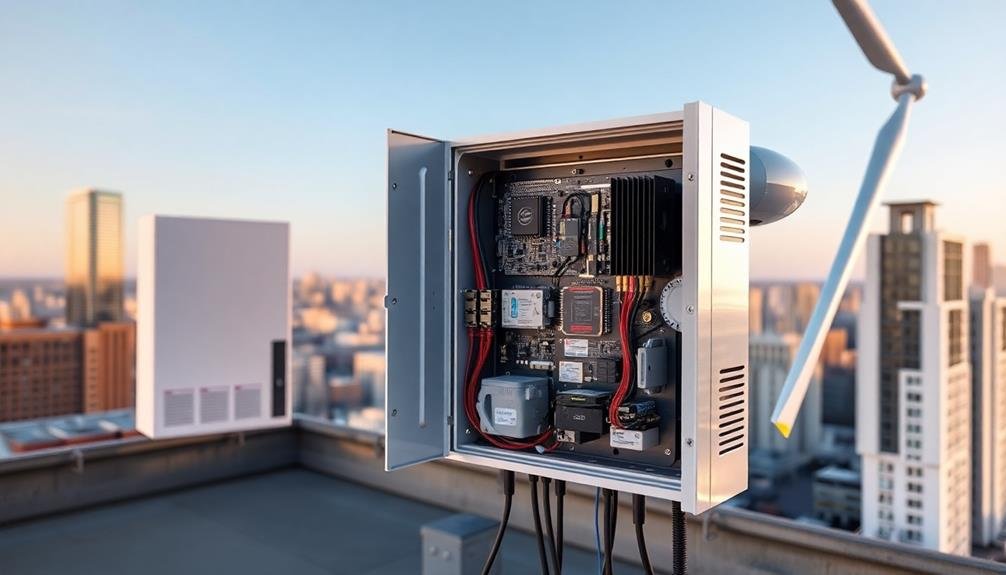
Efficiency is paramount when selecting an inverter for your vertical axis wind turbine (VAWT). You'll want to maximize power output while minimizing losses, ensuring ideal performance of your system. Look for inverters with high conversion efficiency, typically above 95%, to make the most of the energy your VAWT generates.
Consider these key factors when evaluating inverter efficiency for your VAWT:
- Maximum power point tracking (MPPT) algorithms
- Low standby power consumption
- Wide input voltage range to accommodate wind speed variations
- Thermal management features to maintain efficiency in various weather conditions
Don't forget to account for partial load efficiency, as VAWTs often operate at less than full capacity due to wind variability. Choose an inverter that maintains high efficiency across a range of power inputs.
Additionally, look for models with advanced grid support features, such as reactive power control and low voltage ride-through capabilities, to meet utility requirements and maximize overall system efficiency.
Grid Synchronization Techniques
Grid synchronization is a key feature of compact inverters for vertical axis wind turbines, building on overall system efficiency. You'll find that proper synchronization guarantees seamless integration of your turbine's output with the utility grid. This process involves matching the frequency, phase angle, and voltage of the inverter's AC output to those of the grid.
Several techniques are available for grid synchronization:
| Technique | Pros | Cons |
|---|---|---|
| PLL-based | High accuracy, robust | Complex implementation |
| Zero-crossing detection | Simple, cost-effective | Less accurate in noisy conditions |
| DQ transformation | Fast response, handles unbalanced grids | Computationally intensive |
| Adaptive filtering | Noise-resistant, flexible | Requires careful tuning |
You'll want to choose a method that balances performance with your inverter's computational capabilities. PLL-based systems are widely used for their reliability, but simpler methods like zero-crossing detection might suffice for smaller installations.
Safety Features in Compact Inverters
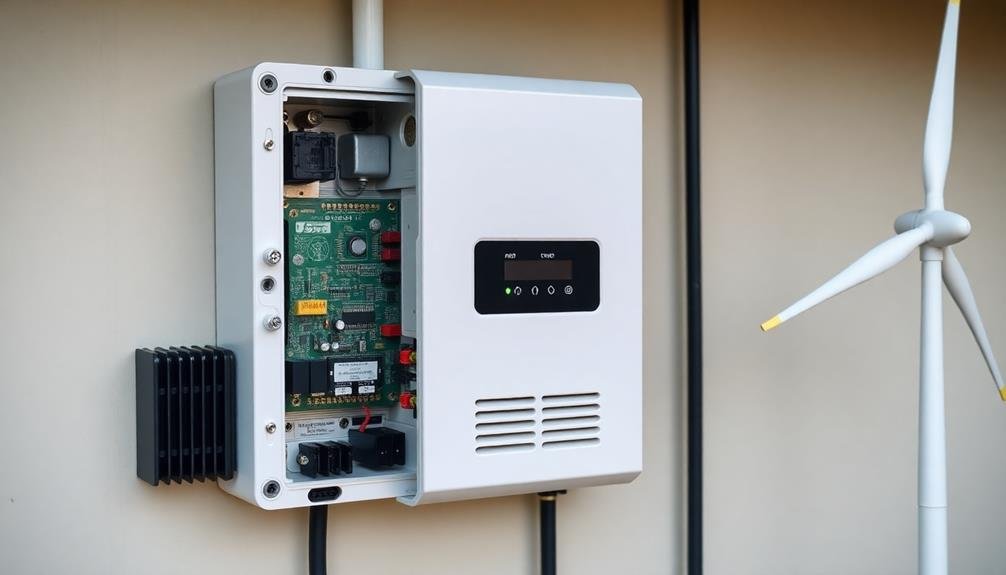
When considering compact inverters for vertical axis turbines, you'll find safety features are paramount.
Automatic shutdown mechanisms guarantee your system responds quickly to potential hazards, preventing damage and protecting personnel.
Additionally, overcurrent protection systems safeguard your inverter and connected equipment from electrical surges, maintaining the longevity and reliability of your turbine setup.
Automatic Shutdown Mechanisms
Safeguarding your vertical axis turbine system is vital, and compact inverters play an important role in this process through their automatic shutdown mechanisms. These mechanisms are designed to protect your turbine, the inverter itself, and the electrical grid from potential damage or instability.
When certain conditions are met, your compact inverter will automatically shut down the system. Common triggers include:
- Overvoltage or undervoltage detection
- Frequency deviations outside acceptable ranges
- Islanding situations, where the grid power is lost
- Overheating of inverter components
You'll find that modern compact inverters often include advanced monitoring systems that continuously check for these issues. They'll react within milliseconds to prevent damage to your equipment or the grid.
Some inverters also feature remote shutdown capabilities, allowing you to deactivate the system from a distance if needed.
It's fundamental to understand that while these mechanisms provide necessary protection, they shouldn't replace regular maintenance and inspections. You should still periodically check your system's components and connections to guarantee peak performance and longevity.
Overcurrent Protection Systems
Compact inverters for vertical axis turbines incorporate three essential overcurrent protection systems to safeguard your equipment and the electrical grid. These systems work together to prevent damage from excessive current flow and maintain safe operating conditions.
First, you'll find fast-acting fuses that quickly interrupt the circuit if current levels exceed safe thresholds. These fuses are designed to blow before any components can be damaged, protecting both the inverter and connected equipment.
Second, the inverter utilizes electronic current limiting circuits. These monitor the current flow in real-time and can rapidly reduce or shut off power output if overcurrent conditions are detected. This feature helps prevent nuisance tripping of fuses and allows for smoother operation during minor fluctuations.
Lastly, you'll benefit from intelligent software-based protection. The inverter's microcontroller constantly analyzes current levels, power output, and grid conditions. It can preemptively adjust power output or disconnect from the grid if it detects potentially harmful situations developing.
Installation Best Practices
To guarantee ideal performance and longevity of compact inverters for vertical axis turbines, proper installation is essential. You'll need to follow specific guidelines to ascertain peak functionality and safety.
Begin by selecting a suitable location for the inverter, preferably in a cool, dry area away from direct sunlight and potential water exposure. Confirm proper ventilation to prevent overheating, which can greatly reduce the inverter's lifespan.
When mounting the inverter, use appropriate brackets and hardware to secure it firmly. You'll want to maintain easy access for maintenance and monitoring. Connect the inverter to your turbine and the grid using correctly sized cables, following manufacturer specifications and local electrical codes. Don't forget to install necessary safety devices, such as circuit breakers and surge protectors.
To create a vivid mental image of the installation process, consider these key steps:
- Mount the inverter securely on a sturdy wall or rack
- Connect the DC input from the turbine to the inverter's terminals
- Wire the AC output to your main electrical panel
- Install monitoring equipment to track performance and detect issues
Maintenance and Troubleshooting
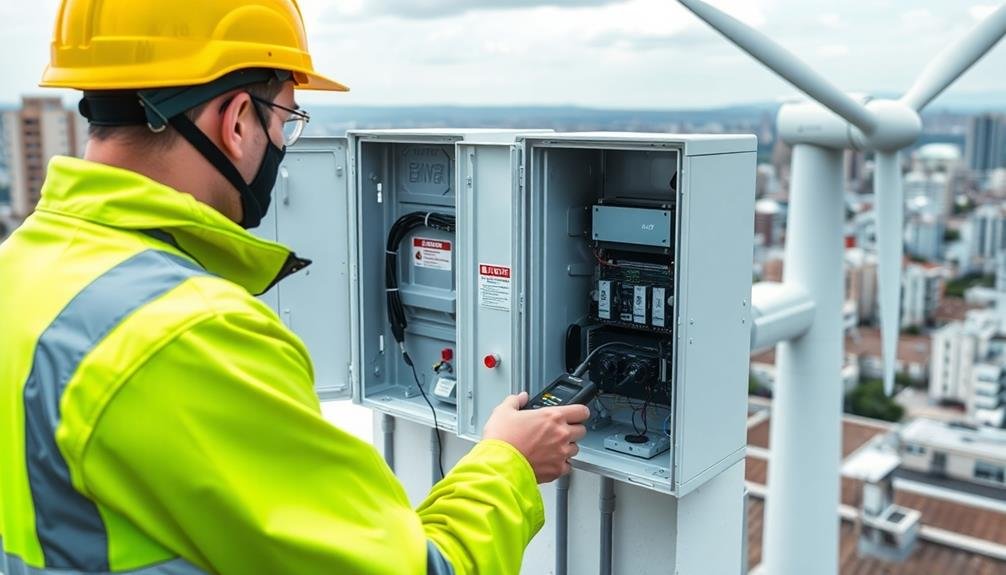
Regular maintenance and effective troubleshooting are key to your compact inverter's ideal performance and longevity. Conduct monthly visual inspections to check for loose connections, corrosion, or physical damage. Clean the inverter's exterior and guarantee proper ventilation to prevent overheating. Monitor the LED indicators regularly for any error codes or abnormal behavior.
If you encounter issues, first consult your inverter's manual for specific troubleshooting steps. Common problems include grid connection failures, which may be resolved by checking fuses and circuit breakers. For communication errors, verify the integrity of data cables and network settings.
If you experience lower-than-expected power output, inspect your turbine for damage and clean its blades.
When troubleshooting doesn't resolve the issue, contact the manufacturer's support team. Keep a log of error messages, operating conditions, and any recent changes to aid in diagnosis. For firmware updates or advanced diagnostics, you may need to connect your inverter to a computer using the manufacturer's software.
Remember to disconnect power sources before performing any internal maintenance or repairs. If you're unsure about a procedure, always consult a qualified technician to guarantee safety and prevent voiding your warranty.
Cost Analysis of Compact Inverters
When considering compact inverters for vertical axis turbines, you'll need to weigh the initial investment against long-term operational savings.
The upfront costs may be higher than traditional inverters, but you'll likely see reduced maintenance expenses and improved energy efficiency over time.
To make an informed decision, you should calculate the total cost of ownership, factoring in purchase price, installation, operational costs, and potential energy savings throughout the inverter's lifespan.
Initial Investment Considerations
Evaluating the initial investment for compact inverters in vertical axis turbine systems requires a thorough cost analysis. You'll need to contemplate several factors when determining the upfront costs associated with these essential components. The inverter's size, power rating, and efficiency will considerably impact its price, as will the brand and warranty options available.
When appraising the initial investment, keep these key points in mind:
- Inverter capacity: Match the inverter's power rating to your turbine's output for peak performance.
- Installation costs: Factor in professional installation fees, which can vary based on complexity and location.
- Grid connection requirements: Verify the inverter meets local utility standards for grid-tied systems.
- Monitoring systems: Reflect on the additional cost of remote monitoring capabilities for performance tracking.
Don't forget to compare the long-term benefits of higher-quality inverters against their initial cost. While premium models may have a steeper upfront price, they often offer improved efficiency, durability, and warranty coverage.
This can lead to lower maintenance costs and higher energy yields over time, potentially offsetting the higher initial investment. Always consult with experienced professionals to make informed decisions tailored to your specific vertical axis turbine project.
Long-Term Operational Savings
While the initial investment in compact inverters for vertical axis turbines can be substantial, the long-term operational savings often justify the upfront costs. You'll find that these inverters markedly reduce energy losses, improving overall system efficiency. This means you'll generate more power from your turbine, increasing your return on investment over time.
Compact inverters require less maintenance than their larger counterparts, cutting down on service costs and downtime. They're designed for durability, often lasting 10-15 years before needing replacement. This longevity translates to fewer replacement expenses over your turbine's lifetime.
You'll also benefit from reduced cooling needs, as compact inverters generate less heat. This leads to lower energy consumption for cooling systems and extends the inverter's lifespan. Additionally, their smaller size means you'll save on installation and housing costs.
Over time, you'll see savings on your electricity bills, especially if you're connected to the grid. The improved efficiency allows you to rely less on grid power, and in some cases, you may even sell excess energy back to the utility company, further offsetting your operational costs.
Regulatory Compliance for Grid Connection

Compliance with grid connection regulations is a vital aspect of deploying compact inverters for vertical axis turbines. You'll need to verify your system meets all local, regional, and national standards for grid-tied renewable energy installations. These regulations typically cover power quality, safety features, and interconnection protocols.
To navigate the regulatory landscape effectively, you should:
- Research and understand the specific grid codes applicable to your area
- Consult with local utility providers to determine their requirements
- Obtain necessary certifications for your inverter and turbine components
- Implement required safety features, such as anti-islanding protection
Your compact inverter must maintain grid stability by providing reactive power support, voltage regulation, and frequency control.
It's critical to incorporate smart grid functionality, allowing for remote monitoring and control by utility operators. You'll also need to address power factor correction and harmonic distortion to meet stringent power quality standards.
Don't forget to document all compliance measures and keep records of testing and certification. This documentation will be vital during inspections and for obtaining final approval to connect your vertical axis turbine system to the grid.
Future Trends in VAWT Inverters
The future of VAWT inverters is shaping up to be exciting and innovative. You'll see a push towards even more compact designs, allowing for easier integration into urban environments.
Expect advancements in power density, with inverters capable of handling higher outputs in smaller packages. Smart grid compatibility will become standard, enabling VAWTs to communicate and respond to grid demands in real-time.
You'll witness improvements in efficiency, with next-generation inverters approaching 99% conversion rates. This will translate to more energy captured from VAWTs making it to the grid.
Modular designs will gain traction, offering scalability and easier maintenance. You'll also see increased focus on fault tolerance and self-diagnostic capabilities, minimizing downtime and improving reliability.
Inverters will incorporate advanced power tracking algorithms, optimizing energy harvest across diverse wind conditions. You can anticipate better heat management solutions, extending inverter lifespan and performance in various climates.
Integration with energy storage systems will become seamless, allowing for more effective use of intermittent wind power. Ultimately, you'll see a trend towards software-defined inverters, enabling remote updates and customization to meet evolving grid requirements and VAWT technologies.
DIY Inverter Integration Tips
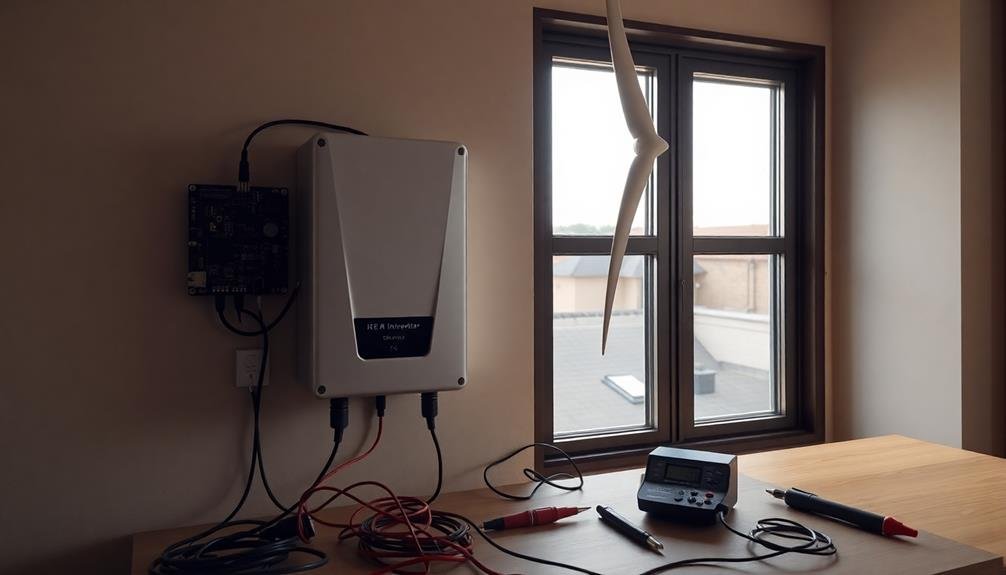
If you're considering integrating an inverter into your DIY vertical axis wind turbine project, there are several key tips to keep in mind. First, verify your inverter's capacity matches your turbine's output. Undersizing can lead to inefficiency, while oversizing wastes money.
Next, prioritize safety by installing proper grounding and surge protection. Don't skimp on quality components, as they'll protect your system and home.
When selecting an inverter, look for models with:
- MPPT (Maximum Power Point Tracking) technology to optimize power output
- Grid-tie functionality for seamless integration with your local power grid
- Remote monitoring capabilities to track performance and troubleshoot issues
- Weather-resistant housing suitable for outdoor installation
Pay attention to local regulations and obtain necessary permits before connecting your system to the grid. It's important to follow manufacturer guidelines for installation and maintenance.
Consider seeking help from a professional electrician if you're unsure about any aspects of the integration process. Regularly inspect your system for wear and tear, and keep detailed records of its performance.
With careful planning and execution, you can successfully integrate a compact inverter into your VAWT setup, enhancing its efficiency and reliability.
Frequently Asked Questions
How Do Compact Inverters for VAWTS Differ From Those Used in Solar Installations?
You'll find that VAWT inverters differ from solar ones in their ability to handle variable input frequencies. They're designed for fluctuating wind speeds, while solar inverters deal with more consistent DC input from photovoltaic panels.
Can Compact Inverters for VAWTS Be Used With Other Renewable Energy Sources?
You can use compact inverters designed for VAWTs with other renewable sources. They're versatile and adaptable. However, you'll need to verify compatibility with the specific energy source's output characteristics and power requirements for peak performance.
What Is the Typical Lifespan of a Compact Inverter for Grid-Tied VAWTS?
You'll typically get 10-15 years from a compact inverter. However, its lifespan can vary based on usage, environmental conditions, and maintenance. Regular check-ups and proper care can help extend its operational life considerably.
Are There Any Specific Environmental Considerations for Installing Compact VAWT Inverters?
You'll need to take into account temperature extremes, humidity, and dust exposure when installing compact inverters. Guarantee proper ventilation and protection from direct sunlight. Don't forget about noise levels and potential electromagnetic interference with nearby electronics.
How Do Compact Inverters Affect the Noise Levels of VAWT Systems?
You'll find that compact inverters generally don't affect noise levels much. They're designed to operate quietly. However, they can slightly reduce overall system noise by allowing for more efficient power conversion, potentially lowering turbine speeds.
In Summary
You've now gained insight into compact inverters for grid-tied vertical axis wind turbines. As you consider implementing this technology, remember to size your inverter correctly, prioritize efficiency, and guarantee regulatory compliance. While costs are important, don't overlook future trends that may impact your system. Whether you're a DIY enthusiast or working with professionals, these inverters offer exciting possibilities for harnessing wind energy. Keep exploring and innovating in this rapidly evolving field.



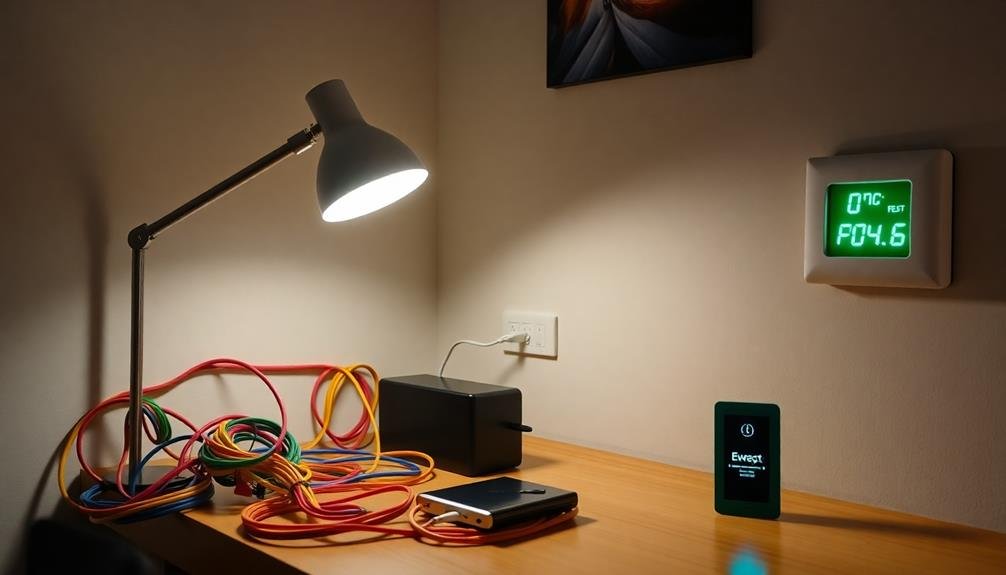

Leave a Reply